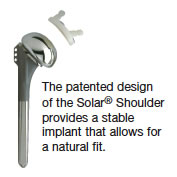Dedicated to Our Patients


 Some Things You Should Know
Some Things You Should Know
Replacement of an arthritic or injured shoulder is less common than knee or hip replacement. When necessary, however, shoulder replacement typically provides the same potential benefits as those procedures, including relief of joint pain and restoration of more normal joint movement.
Restoration of movement is particularly important in the shoulder, the body mechanism that allows your arm to rotate in every direction. If you’re experiencing severe shoulder pain and reduced shoulder movement, there are probably many daily activities you can no longer do — or do as well or as comfortably — as before your shoulder problems began.
In shoulder replacement surgery, the artificial shoulder joint can have either two or three parts, depending on the type of surgery required.
There are two types of shoulder joint replacement procedures:
How Long Will an Artificial Shoulder Joint Last?
How long a joint replacement will last is impossible to predict. Individual results vary. As successful as most of these procedures are, over the years the artificial joints can become loose and unstable or wear out, requiring a revision (repeat) surgery. Many factors determine the outcome including:
Loosening is a common cause of joint replacement surgery failure. A small amount of loosening and bone loss will occur. If it reaches a certain degree, a revision surgery may be indicated.
Stryker Corporation or its divisions or other corporate affiliated entities own, use or have applied for the following trademarks or service marks: Solar and Stryker. All other trademarks are trademarks of their respective owners or holders.